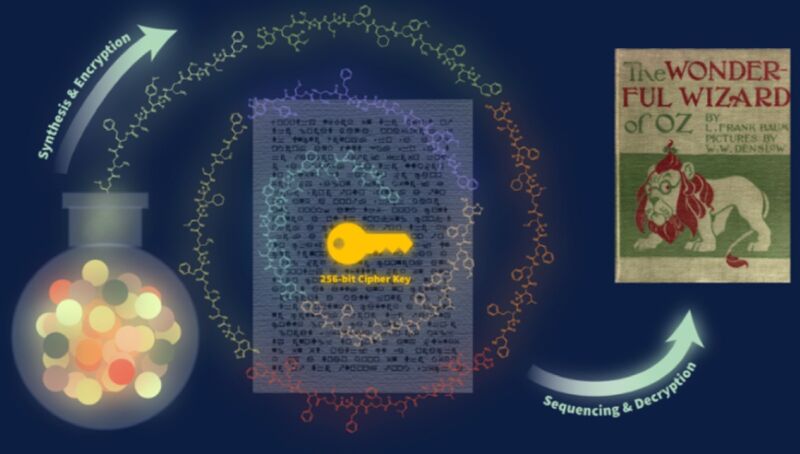It’s “a revolutionary scientific advance in molecular data storage and cryptography.”

Scientists from the University of Texas at Austin sent a letter to colleagues in Massachusetts with a secret message: an encryption key to unlock a text file of L. Frank Baum’s classic novel The Wonderful Wizard of Oz. The twist: The encryption key was hidden in a special ink laced with polymers, They described their work in a recent paper published in the journal ACS Central Science.
When it comes to alternative means for data storage and retrieval, the goal is to store data in the smallest amount of space in a durable and readable format. Among polymers, DNA has long been the front runner in that regard. As we’ve reported previously, DNA has four chemical building blocks—adenine (A), thymine (T), guanine (G), and cytosine (C)—which constitute a type of code. Information can be stored in DNA by converting the data from binary code to a base-4 code and assigning it one of the four letters. A single gram of DNA can represent nearly 1 billion terabytes (1 zettabyte) of data. And the stored data can be preserved for long periods—decades, or even centuries.
There have been some inventive twists on the basic method for DNA storage in recent years. For instance, in 2019, scientists successfully fabricated a 3D-printed version of the Stanford bunny—a common test model in 3D computer graphics—that stored the printing instructions to reproduce the bunny. The bunny holds about 100 kilobytes of data, thanks to the addition of DNA-containing nanobeads to the plastic used to 3D print it. And scientists at the University of Washington recently recorded K-Pop lyrics directly onto living cells using a “DNA typewriter.”
But using DNA as a storage medium also presents challenges, so there is also great interest in coming up with other alternatives. Last year, Harvard University scientists developed a data-storage approach based on mixtures of fluorescent dyes printed onto an epoxy surface in tiny spots. The mixture of dyes at each spot encodes information that is then read with a fluorescent microscope. The researchers tested their method by storing one of 19th-century physicist Michael Faraday’s seminal papers on electromagnetism and chemistry, as well as a JPEG image of Faraday.
Other scientists have explored the possibility of using nonbiological polymers for molecular data storage, decoding (or reading) the stored information by sequencing the polymers with tandem mass spectrometry. In 2019, Harvard scientists successfully demonstrated the storage of information in a mixture of commercially available oligopeptides on a metal surface, with no need for time-consuming and expensive synthesis techniques.
This latest paper focused on the use of sequence-defined polymers (SDPs) as a storage medium for encrypting a large data set. SDPs are basically long chains of monomers, each of which corresponds to one of 16 symbols. “Because they’re a polymer with a very specific sequence, the units along that sequence can carry a sequence of information, just like any sentence carries information in the sequence of letters,” co-author Eric Anslyn of UT told New Scientist.
But these macromolecules can’t store as much information as DNA, per the authors, since the process of storing more data with each additional monomer becomes increasingly inefficient, making it extremely difficult to retrieve the information with the current crop of analytic instruments available. So short SDPs must be used, limiting how much data can be stored per molecule. Anslyn and his co-authors figured out a way to improve that storage capacity and tested the viability of their method.
First, Anslyn et al. used a 256-bit encryption key to encode Baum’s novel into a polymer material made up of commercially available amino acids. The sequences were comprised of eight oligourethanes, each 10 monomers long. The middle eight monomers held the key, while the monomers on either end of a sequence served as placeholders for synthesis and decoding. The placeholders were “fingerprinted” using different isotope labels, such as halogen tags, indicating where each polymer’s encoded information fit within the order of the final digital key,
Then they jumbled all the polymers together and used depolymerization and liquid chromatography-mass spectrometry (LC/MS) to “decode” the original structure and encryption key. The final independent test: They mixed the polymers into a special ink made of isopropanol, glycerol, and soot. They used the ink to write a letter to James Reuther at the University of Massachusetts, Lowell. Reuther’s lab then extracted the ink from the paper and used the same sequential analysis to retrieve the binary encryption key, revealing the text file of The Wonderful Wizard of Oz.
In other words, Anslyn’s lab wrote a message (the letter) containing another secret message (The Wonderful Wizard of Oz) hidden in the molecular structure of the ink. There might be more pragmatic ways to accomplish the feat, but they successfully stored 256 bits in the SDPs, without using long strands. “This is the first time this much information has been stored in a polymer of this type,” Anslyn said, adding that the breakthrough represents “a revolutionary scientific advance in the area of molecular data storage and cryptography.”
Anslyn and his colleagues believe their method is robust enough for real-world encryption applications. Going forward, they hope to figure out how to robotically automate the writing and reading processes.
DOI: ACS Central Science, 2022. 10.1021/acscentsci.2c00460 (About DOIs).



